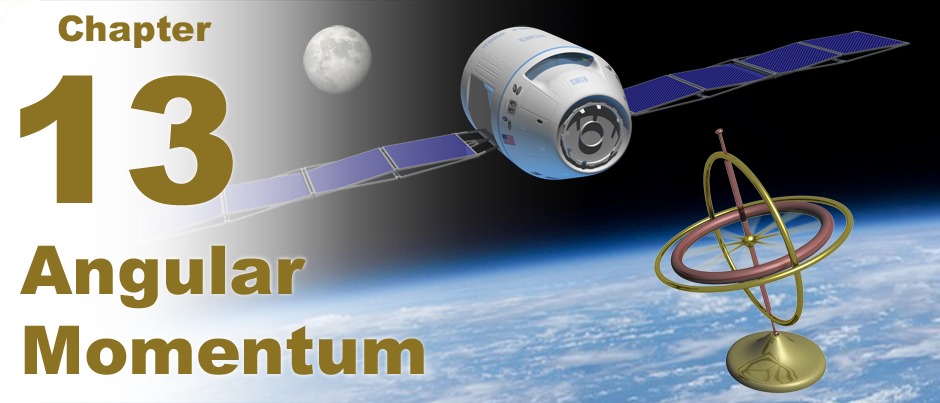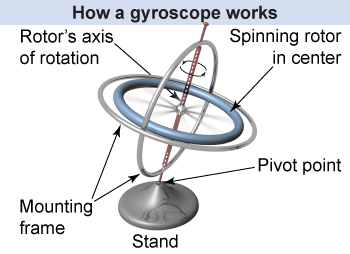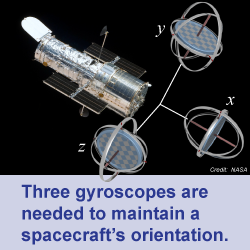 |
How can you prevent a spacecraft from spinning out of control? How does a smartphone, tablet computer, or hand-held controller for a video game sense that it has been tilted or turned? The answer is a gyroscope, and the physics behind it is the conservation of angular momentum. 
|
 The heart of a gyroscope is a rotor, which is a disk that spins about an axle connected to the frame. Inexpensive, commercially available gyroscopes, such as the one at right, are mounted inside a fixed frame that consists of two metal rings. You start the gyroscope by spinning the rotor fast, often by pulling a string wound around the axle. Anything that rotates possesses angular momentum—just as anything moving in a straight line possesses linear momentum. The angular momentum from the gyroscope’s spinning motion keeps it from falling over. You can even balance a spinning gyroscope on the tip of a pencil!
The heart of a gyroscope is a rotor, which is a disk that spins about an axle connected to the frame. Inexpensive, commercially available gyroscopes, such as the one at right, are mounted inside a fixed frame that consists of two metal rings. You start the gyroscope by spinning the rotor fast, often by pulling a string wound around the axle. Anything that rotates possesses angular momentum—just as anything moving in a straight line possesses linear momentum. The angular momentum from the gyroscope’s spinning motion keeps it from falling over. You can even balance a spinning gyroscope on the tip of a pencil! 
 |
The angular momentum of the spinning gyroscope is the key to preventing it from toppling over. But what if you start it spinning in a horizontal position? Even then, the angular momentum resists the torques from gravity that you might think would cause it to topple over. Instead, the whole gyroscope slowly spins about its base, a phenomenon called precession. You will learn more about precession at the end of the chapter! 
|
 When spacecraft leave the Earth’s surface, they cannot use the Earth’s magnetic field to tell direction. They use gyroscopes instead! When a spacecraft tilts in one direction, sensors in a gyroscope detect the spacecraft’s tilt with respect to the desired orientation of the spinning rotor—and the spacecraft’s attitude (its orientation relative to an inertial frame of reference) can be adjusted to compensate. Three dimensions (the x-, y-, and z-axes) are needed to define the spatial coordinate system or inertial reference frame, so a spacecraft needs at least three gyroscopes to maintain its orientation.
When spacecraft leave the Earth’s surface, they cannot use the Earth’s magnetic field to tell direction. They use gyroscopes instead! When a spacecraft tilts in one direction, sensors in a gyroscope detect the spacecraft’s tilt with respect to the desired orientation of the spinning rotor—and the spacecraft’s attitude (its orientation relative to an inertial frame of reference) can be adjusted to compensate. Three dimensions (the x-, y-, and z-axes) are needed to define the spatial coordinate system or inertial reference frame, so a spacecraft needs at least three gyroscopes to maintain its orientation. 
|
Many smartphones and hand-held video game consoles measure the rotation or tilt of the device using accelerometers and gyroscopes, but not the clunky ones pictured above. Instead, they use a vibrating structure gyroscope as part of a tiny chip called a microelectromechanical system (MEMS). These solid state gyroscopes are also used in two-wheeled, self-balancing personal transporters, such as the Segway® PT. 
|
| |
|

